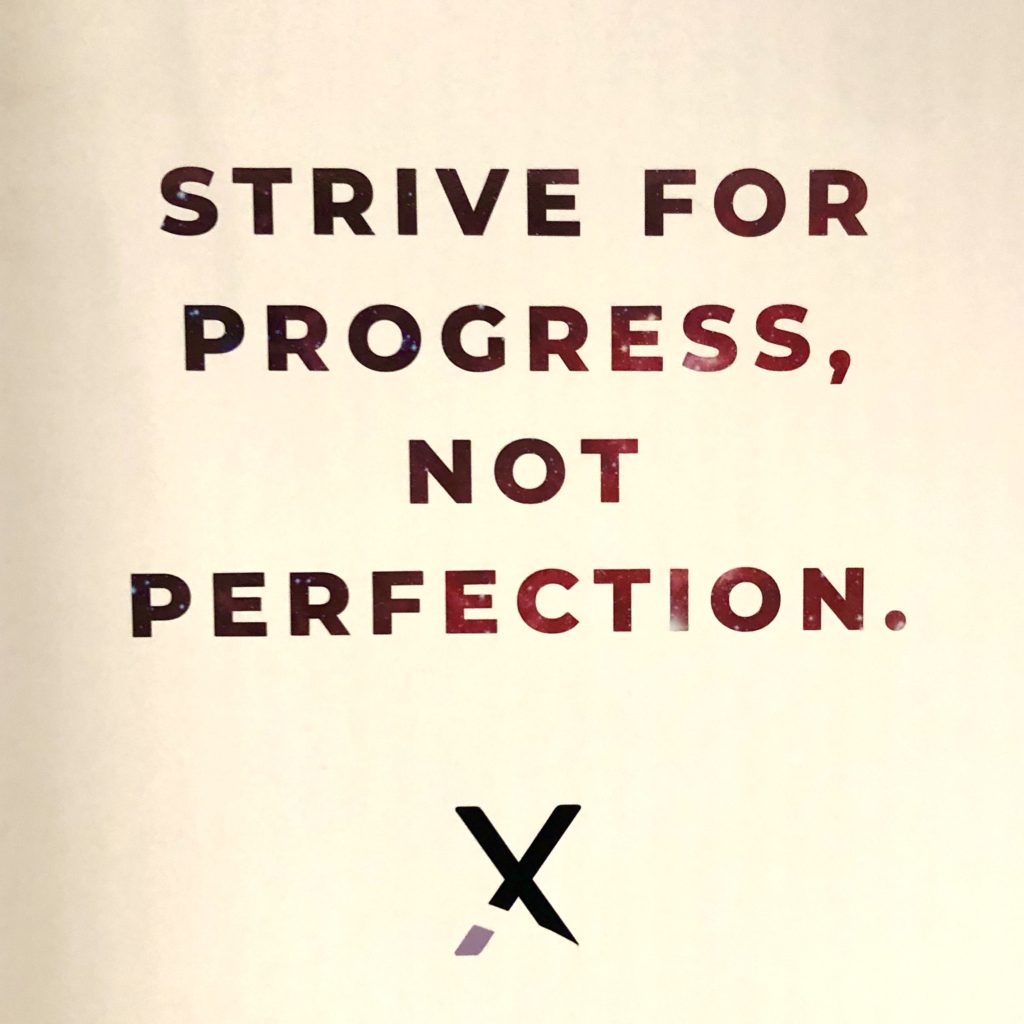Working from home. Socializing from home. Exercising from home.
Everything from home!
This is our new reality. For now…
All has changed. But not all is lost.
It’s time to adapt. Here are three work from home guidelines to keep in mind as you’re creating your new normal.
As Bruce Lee said, take what is useful, adapt what you can, and discard the rest.
Work From Home Guideline #1: Give Yourself (And Others) Grace

Coronavirus thrust us into a new reality. We’re all scrambling to find a way forward.
The question is whether you will breakdown into anxiety and overwhelm, or march forward, one day at a time, with as much grace as possible.
Acknowledge The Trauma
It’s all too easy to skip over this step. But you’ll regret it in the long run.
This is hard. For everyone.
It’s okay to be angry, upset, and frazzled. Give yourself room to digest the experience, personally and collectively.
To stay grounded and sane, you need a grace period. Specifically, you need to grieve your losses.
Because of all this you may have lost your:
- Comfortable day-to-day routine
- Significant life events due to cancellations
- Opportunities to work and earn income
- Freedom to move around and travel
- Time to yourself
- Time together
- Ability to give hugs, hold hands, and be held
- Meals at your favorite restaurant
- And so much more…
We all need some time to mourn. We need permission to feel our sorrow.
Not to linger there indefinitely, but to give our hurt the honest attention it deserves.
Grace Is Permission To Relax
Give yourself permission to indulge, permission to seek comfort, and most importantly, permission to not get it all done today.
You’re not in the office. You have different constraints, different schedules, and different levels of support or distraction.
Things might not move as quickly or efficiently as you planned. That’s ok.
Be honest about where you are. Recognize your capacity to carry on with your work and ask for help if you’re feeling overwhelmed.
Then relax. We all need and deserve pleasure. Even more so when being stuck at home has denied you of previous activities that cheered you up.
If you can relax, you help others around you relax. If you can lower your stress, you help others do the same. Make the change for yourself and then hold the space for others to join.
Grace Allows You To Surrender
Surrender to that which you cannot change. You did not choose to work from home. You did not decide it would be nice to close everything and have your life up-ended. This was thrust upon all of us.
But here we are. We can’t turn back time, and unfortunately, we don’t know how long this will last. We need to surrender to the uncertainty and let go of what we cannot control.
This is hard, I know. Our minds and our society are not very good at accepting so much uncertainty, let alone trying to embrace it.
Grace Is About Moving Forward, Not Staying Stuck
This is not about bypassing what needs to get done. It’s about gathering yourself to move forward with grace, recognizing that “forward” does not mean “normal”. Things are not like before. They may never be.
Moving forward with grace asks you to meet the unknown of today with kindness. It asks you to keep your heart open, because we are all vulnerable right now. This shared defenselessness is scary but is also the source of our deepest connection.
A graceful person is elegant and beautiful in how they can embody the struggle and the strength of this crazy situation. Move forward gracefully.
Extend Grace To Others
To make it through this, we need to allow grace to take root and blossom in all of us. We need to offer others the same opportunity to grieve, permission to be happy, and release of fear that we offer ourselves.
Giving grace wherever you can, especially to those putting themselves at risk because they have no other choice, is part of the privilege of working from home.
Work From Home Guideline #2: Routines Rule

Routines help us feel in control. When there is so much outside of our control, daily schedules are essential. The structure of routines counterbalances the unknown and letting go.
Some of your previous routines may still be intact. If they’re supporting you and those around you, keep going.
Other routines you had may no longer be possible. It’s time to get creative to build new and improved practices working from home.
Look For Opportunities: What Is Possible Now?
Rather than focusing on the negatives, consider what you have gained.
What possibility exists now that didn’t exist just a few weeks ago?
- Maybe you don’t have to wake up as early?
- Maybe you don’t have to be beholden to a bus or a train schedule?
- Maybe you have time to cook and organize?
- Maybe you can work on projects you’ve consistently put off?
Capitalize On Transitions
You win at the margins. Commutes are dead so you can reallocate those minutes elsewhere. Anytime you used to spend in transit or waiting around can be spent being present where you are. There are endless opportunities to practice mindfulness and reconnect with what’s truly important.
The flipside is the challenge of having no transitions. That walk to grab lunch might have given you social time with colleagues. That commute home might have provided the necessary headspace to let go of work and reenter the household.
Since these changeover spaces are gone, you need to build-in transitions that enable you to shift gears even when you can’t shift environments.
The way to do this is by changing your focus and changing your body.
Stand, stretch, or go for a walk if possible. Have a transition activity like a puzzle to allow your mind to unfocus for a moment. Give yourself time to digest and absorb one thing before diving into the next.
Plan Activities To Look Forward To
Whether you’re working from home alone, with roommates, or family, it doesn’t need to be dull. You can still have fun.
In fact, it’s vital to have something to look forward to each day so you don’t feel trapped. There a lot of pleasure in anticipation of something fun to do later.
Your options may be simple, but they can still be satisfying.
- Create a “date night” by ordering food from your favorite place and queuing up a movie to watch.
- Plan, cook, and eat a special meal together that is different from your normal.
- Play games: improv, trivia, board games, puzzles, charades, video games, etc.
- Walk or ride bikes if you can.
- Gather with friends virtually.
Once you’ve found something to look forward to, put them into your schedule just as you would if you were going out. Remember the anticipation is just as important as the activity.
Schedule To Move Energy Throughout Your Day
Gyms and fitness studios are closed. And let’s be honest, it stinks.
An essential work from home guideline is to not give up on your workout routine. You can still move, exercise, and do amazing things with your body at home.
It’s vital for your physical and mental health to stay active. Thankfully there’s been an outpouring of generosity and free online movement classes you can enjoy at home.
However, don’t obsess about losing your gains or needing to workout three times a day. If you identify fitness as a marker of your self-worth, this is your chance to let go of your exercise compulsions.
Obsessive fitness is not what the world needs from you right now.
Of course, working from home tends to be sedentary and confined. Energy builds up. But it’s not just physical energy that needs to move through you, mental, emotional, and spiritual energy can also become stagnant if you’re stuck in front of a screen all day.
Build your daily schedule to allow energy to move through you. This is more than just working out. It is having conversations, coming back to your breathing, and engaging in creative pursuits.
All these activities help move, balance, and regulate energy flowing in and out during the day.
Don’t wait until you feel like you’re about to jump out of your pants. Make them part of your daily routine.
Build Intentional Community Into Everyday
Socializing has to be redefined. Community now exists virtually or at a distance.
But this doesn’t mean social time doesn’t matter. You just need to be more intentional about creating connections.
- First, create time for your whole household to come together. Even if this doesn’t seem like a smart or efficient thing to do, it keeps the organism of your home synchronized. Ask your household to make some time to just be together as a unit. It will strengthen everyone.
- Second, strengthen existing relationships via phone or video. Reach out to those you haven’t talked to in a while. Check-in. See how people living in different cities or countries are handling all this. Commiserate and build solidarity in this shared experience.
- Thirdly, find ways to stay engaged with your local community. If you can, buy from local vendors. Donate to local agencies. Call your neighbors and ask if there’s anything you can do for them. Smile and say hello (at a distance).
You are not separate from the health of your community. When your neighborhood is connected and health, your wellbeing increases.
As Adrienne Maree Brown says in the book Emergent Strategy, “It’s not a singular task, to be responsible for what happens in this world—we do not exist or transform in isolation.”
Set aside time in your day to connect with others beyond your working world. Schedule recurring calls or weekly hangouts. Build a routine of checking-in with people, not only so you don’t feel isolated, but because it shows you care.
Work From Home Guideline #3: Boundaries Buffer Stress

You’ve lost the ability to change your environment by leaving for work. But you can still control aspects of your time, space, and focus. To prevent everything from blending together into one unproductive at-home medley, boundaries are essential.
Healthy boundaries depend on a few crucial elements:
- Identify Needs & Wants: Identify for yourself what is essential (need) and what is preferable (want). Where do you draw the line? What are the consequences of not getting your needs met?
- Communicate Clearly: Discuss how you can create spaces and times that enable you to get your needs met. Ask for what you want, but don’t demand it. Accept that some things may not be possible given your situation.
- Cooperate & Compromise: If you’re sharing limited space with others, acknowledge that you’re needs are not the only ones that are important. Work with what you’ve got to ensure that everyone is getting their needs met to the best of their ability. Where are you willing to compromise? How can you share responsibility?
Boundaries are mutually beneficial to everyone. They make it clear what is important and what is acceptable.
Keep in mind that in close quarters with limited options, boundaries will be tested. It won’t be easy sharing so much time and space with the same people.
You need to be respectful and considerate. Look for win-win situations not tit-for-tat squabbles.
There’s no right or wrong in the boundary world. There’s just decisions about where you draw the line.
You need to be clear. If you don’t say anything, you can’t expect others to guess what you need.
In this way, boundaries protect you from being a victim and protect others from unknowingly stepping on your toes.
Remember that saying no is not about shutting others out. It’s about protecting what matters to you. In this case, your work, your body, and your sanity.
As Ed Batista says in his article, “Working From Home…Together, ” Boundaries can be temporal, physical, or cognitive.
- Temporal boundaries designate certain times for certain activities. This links back to work from home guidelines #2: Routines. Block times for activities that enable you to move energy, do work, create connection, and have anticipation and pleasure.
- Physical boundaries designate certain places for certain activities. This is tough when you share space. Use headphones to cancel background noise. Set up signals to others if you’re on a call or cannot be disturbed. Create makeshift offices for work-related activities. Conversely, dedicate space for non-work activities to ensure work doesn’t bleed over into somewhere it doesn’t belong.
- Cognitive boundaries direct your attention toward an object or task (and away from distractions). As much as you can minimize distraction in your immediate work area. It’s ok to feel unmotivated to work (see work from home guideline #1: Give Yourself Grace) but you can remove any barriers that might further diminish your ability to focus. An organized space is key.
A Final Work From Home Guideline: Ask “Who Will I Become As A Result Of All This?”

Social distancing and forced shutdowns can feel like being on house arrest. It will take time to adjust. The hard part is that none of us know how long this will last.
We are social animals. We need each other and we need connection. Isolation is devastating to our health and wellbeing.
Be we can be socially connected while physically distant. We are all figuring this out together.
The key is to let go of ideas of what perfection looks like. In fact, we need to go of what life looked like before the coronavirus. The best place to focus is on the day right in front of you.
Despite the challenges of working from home, there is still a lot you can control. You can give yourself a little grace, make a daily schedule with routines that support you and your household, and create boundaries that allow you to protect your space and your sanity.
We will make it through this, one day at a time,
~ Jeff Siegel
Want to up your focus and productivity? Schedule a free 20-min consultation call with me.
Download your Free Healthy Habit Workbook & Checklist to help you get through these tough times.



5 Comments